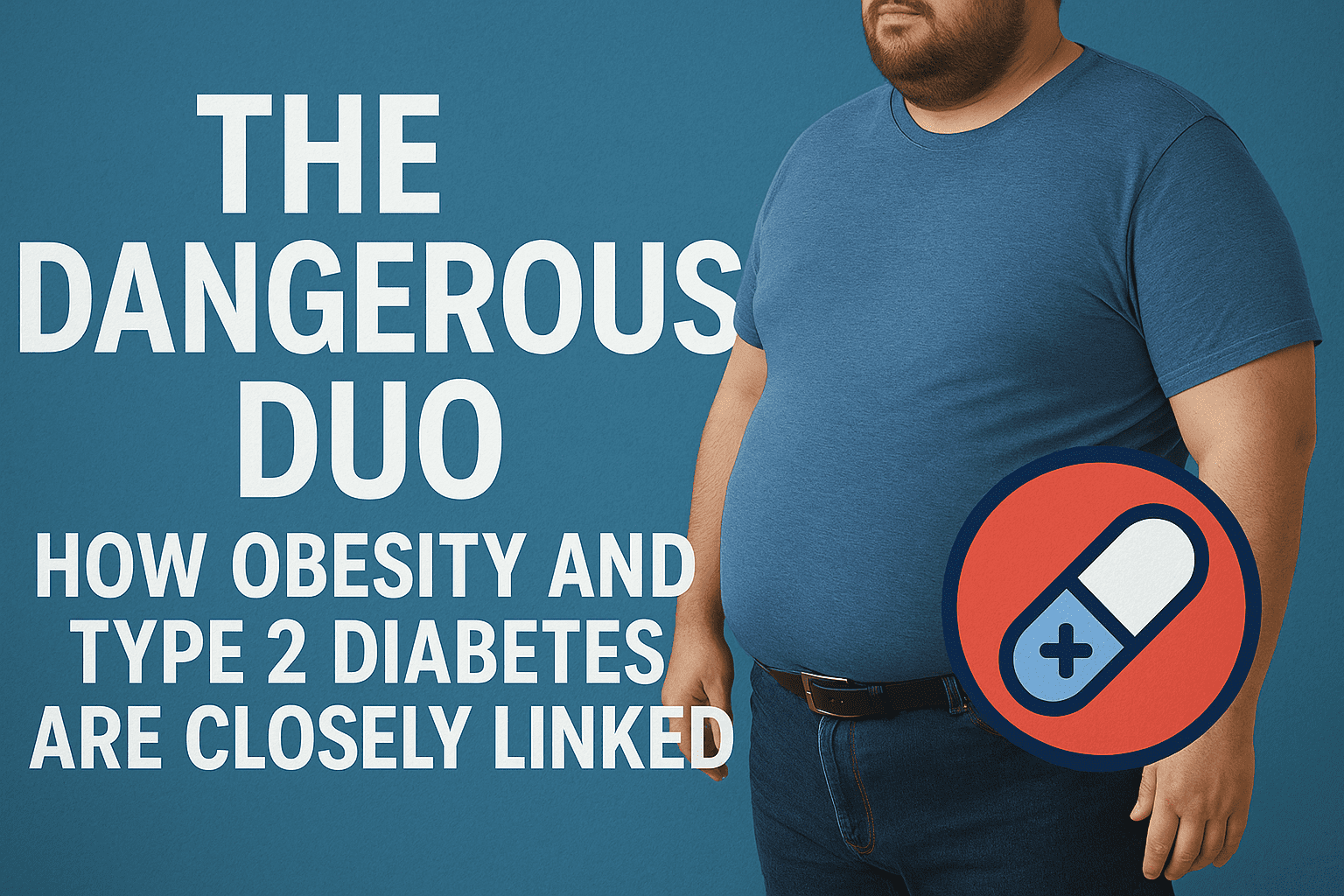Obesity and type 2 diabetes are often called “twin epidemics” — and for good reason. These two conditions not only frequently occur together, but also fuel and worsen each other in a dangerous health cycle.
But how exactly are they connected? And can we break the link before it leads to serious illness?
Let’s explore the science, the risks, and what you can do about it.
First, the Basics
What Is Obesity?
Obesity is defined as having too much body fat — usually a Body Mass Index (BMI) of 30 or higher. But it’s not just about weight — it’s about fat distribution, especially visceral fat (fat around the organs).
What Is Type 2 Diabetes?
Type 2 diabetes is a condition where the body becomes resistant to insulin, the hormone that helps move sugar (glucose) from your bloodstream into your cells. Over time, the pancreas can’t keep up, leading to high blood sugar levels — which damage organs, nerves, and blood vessels.
The Link: How Obesity Triggers Diabetes
1. Insulin Resistance
Fat cells — especially those deep in the abdomen — interfere with insulin. As body fat increases, your cells become less sensitive to insulin, forcing your pancreas to work overtime.
🧪 Example:
Imagine insulin as a key and your cells as locks. Obesity causes the locks to rust, so the key doesn’t work as well.
Eventually, the pancreas can’t keep up — and blood sugar builds up in the bloodstream. This is the start of type 2 diabetes.
2. Chronic Inflammation
Fat tissue isn’t just a storage site — it’s active and produces inflammatory chemicals (cytokines). These chemicals can:
- Worsen insulin resistance
- Damage blood vessels
- Trigger other metabolic problems
The more body fat, the more inflammation — creating a dangerous loop.
3. Hormonal Imbalance
Obesity disrupts hormones like:
- Leptin (which regulates hunger)
- Adiponectin (which enhances insulin sensitivity)
These changes increase appetite, promote fat storage, and make it harder to regulate blood sugar.
Real-World Impact
- About 90% of people with type 2 diabetes are overweight or obese.
- According to the CDC, people with obesity are 6 times more likely to develop type 2 diabetes than those at a healthy weight.
- Diabetes and obesity cost the U.S. hundreds of billions annually in healthcare expenses and lost productivity.
Case Example
Let’s look at Raj, a 45-year-old man with a BMI of 33. He has a family history of diabetes and recently noticed increased thirst, frequent urination, and fatigue.
A blood test reveals:
- Fasting blood sugar: 142 mg/dL
- HbA1c: 7.2%
He is diagnosed with type 2 diabetes.
His doctor explains that his abdominal obesity has likely contributed to insulin resistance, and that weight loss of even 5–10% could drastically improve his blood sugar.
Health Risks When Both Conditions Co-Exist
When a person has both obesity and type 2 diabetes, the risks multiply:
| Condition | Risk Increase |
|---|---|
| Heart disease | 2–4x higher |
| Stroke | 2x higher |
| Kidney failure | Major risk |
| Eye problems (retinopathy) | Common complication |
| Nerve damage (neuropathy) | Can lead to limb amputation |
This combination is sometimes referred to as “diabesity.”
How to Break the Cycle
✅ 1. Lose Weight (Even a Little!)
Losing just 5–7% of body weight can:
- Lower blood sugar
- Improve insulin sensitivity
- Delay or prevent diabetes in at-risk individuals
✅ 2. Improve Your Diet
- Prioritize: whole grains, lean proteins, vegetables, healthy fats
- Reduce: sugar, refined carbs, ultra-processed food
✅ 3. Get Active
- Even 30 minutes of walking daily can boost insulin sensitivity
- Resistance training builds muscle, which helps control glucose
✅ 4. Medications & GLP-1 Drugs
Modern medications like:
- Metformin
- GLP-1 receptor agonists (Ozempic, Mounjaro) can help with both weight loss and blood sugar control
✅ 5. Routine Monitoring
Keep tabs on:
- Blood sugar (HbA1c)
- Blood pressure
- Cholesterol
- Weight and BMI
Final Thoughts
Obesity doesn’t guarantee diabetes — but it raises the risk dramatically. The good news? Type 2 diabetes is often preventable and reversible, especially in its early stages.
Whether you’re managing one condition or trying to prevent both, the key lies in sustainable lifestyle changes and early medical support.
Because the more you understand the link between obesity and type 2 diabetes, the better equipped you are to break it.
📚 References:
- Centers for Disease Control and Prevention (CDC). Obesity and Diabetes Statistics.
- American Diabetes Association. Standards of Medical Care in Diabetes – 2024.
- Harvard Health. The Role of Inflammation in Type 2 Diabetes and Obesity
- WHO. Global Report on Diabetes. https://www.who.int/diabetes



